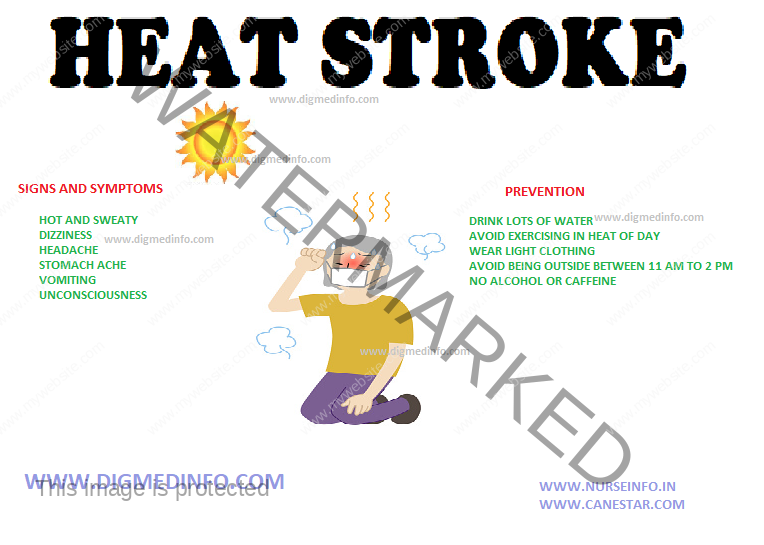Definition, Etiology, Pathogenesis, Clinical features, Complications, Diagnosis, Treatment, Prognosis, Treatment and Prevention.
DISORDERS CAUSED BY HEAT
DEFINITION
Heatstroke follows exposure to heat and is characterized by hyperpyrexia owing to deranged heat regulatory mechanism. Heatstroke is defined clinically as a core body temperature that rises above 40°C and that is accompanied by hot, dry skin and central nervous system abnormalities such as delirium, convulsions, or coma.
ETIOLOGY
Heatstroke results from exposure to a high environmental temperature (classic,or nonexertional heatstroke) or from strenuous exercise (exertional heatstroke). Neuropsychiatric disturbances are prominent. Heatstroke generally occurs at temperatures ranging from 40 to 45o C, but may also occur at wet bulb temperatures as low as 30-35o C, especially if the humidity is high. The external temperature at which heatstroke occurs varies between individuals and therefore is not a reliable parameter for diagnosis. Precipitating factors include lack of acclimatization, unaccustomed and sustained heavy work at high temperatures, alcoholism, infections, dehydration, use of drugs like atropine, antihistamines, phenothiazines, antidepressants and diuretics, and obesity.
PATHOGENESIS
The systemic and cellular responses to heat stress include thermoregulation, an acute-phase response whereby various cytokines and acute phase proteins are liberated, and the production of heat-shock proteins. Increased levels of heat-shock proteins in a cell induce a transient state of tolerance to heat stress, allowing the cell to survive. Thermoregulatory failure, exaggeration of the acute phase response, and alteration in the expression of heat-shock proteins may contribute to development of heatstroke.
Clinical features:
The onset is sudden or even abrupt with a rapid rise of body temperature to 41oC or more with acute neurological features such as confusion, restlessness, delirium, agitation, convulsions and coma. In a few patients there may be prodromata, including headache, giddiness, thirst, irrational behaviour and restlessness, and the onset is gradual.
The cardinal diagnostic features are hyperpyrexia, neuropsychiatric disturbances, and a hot and dry skin (hot dry man). The temperature (oral or rectal) varies from 41.5 to 44oC. It is preferable to take the rectal temperature in these cases. The patient has tachycardia and tachypnea. 25% of patients have hypotension. Electrocardiogram shows T wave changes suggestive of myocardial involvement.
Complications
The most serious complication of heatstroke is multi-organ dysfunction. This includes encephalopathy, rhabdomyolysis, acute renal failure, acute respiratory distress syndrome, myocardial injury, hepatocellular injury leading to jaundice, intestinal ischemia or infarction, pancreatic injury, and hemorrhagic complications, especially due to disseminated intravascular coagulation. Untreated, the condition is fatal owing to circulatory, hepatic or renal failure.
Diagnosis:
Diagnosis should be suspected in the presence of the three cardinal features, viz. hyperpyrexia, neurologic disturbances, and a hot and dry skin in a subject exposed to high ambient temperature. It is important to rule out falciparum malaria. Malaria may coexist with heatstroke but in cerebral malaria the peripheral blood will show signs of malaria hyperinfection. Other conditions like septicemia, typhus, pyogenic meningitis, encephalitis, pontine hemorrhage and closed head injuries have to be excluded.
Laboratory features
Laboratory features of heatstroke include neutrophil leucocytosis, thrombocytopenia, elevation of blood urea bilirubin, uric acid, and reduction of plasma bicarbonate, potassium, sodium, calcium and phosphorus. None of these are diagnostically specific. Therefore, diagnosis has to be clinical.
Treatment:
Heatstroke is a medical emergency. Treatment aims at the reduction of the rectal temperature to 39Oc within one hour, restoration of circulating blood volume and support of various organ system functions.
The patient is covered with wet sheets or towels and sprayed with cold water while air is blown or fanned over him to promote evaporative cooling. The patient should preferably be in the lateral recumbent position or hands and knees position to expose as much of skin as possible to the air. As an alternative the patient may be immersed in cold water. Immersion in ice water is not preferred because of the possibility of shivering and hypotension.
The limbs are gently massaged to promote circulation. When the rectal temperature falls to 39oC the patient is transferred to a cool room and watched for further rise of temperature. Recurrence is quite common and temperature regulation may remain unstable for weeks.
Rapid cooling to rectal temperatures below 38-39oC may precipitate convulsions, vomiting and hypotension. A mechanical body cooling unit is available in which cold water at 20oC is sprayed over the patient, while a blast of hot air at 50oC is blown from above. This prevents vasoconstriction and also augments evaporation. Prompt and effective cooling restores neurological functions in the majority of patients. Recovery of central nervous system function is a favorable prognostic sign.
Chlorpromazine (25-50 mg) administered intravenously is a useful adjunct during cooling. Antipyretics like acetaminophen and aspirin have no role and are contraindicated also.
If there is suspicion of malaria, antimalarials are given parenterally. Shock and cardiac failure have to be treated appropriately. The patient should also be observed and treated for renal failure due to rhabdomyolysis, disseminated intravascular coagulation and hepatic failure. Maintenance of hydration and electrolyte balance are important to prevent renal failure. Sequelae include headache, insomnia, giddiness, cerebellar dysfunction and even coma. Most of these clear up in the course of weeks or months.
Prognosis:
If left untreated, 50 -70% of subjects die of heatstroke. Early treatment reduces the mortality to 15-20%. Shock also carries a bad prognosis. Presence of other systemic diseases and extremes of age worsen the prognosis.
Prevention:
Heatstroke is a preventable disease. To prevent heatstroke, people should acclimatize themselves to heat, schedule outdoor activities during cooler times of the day, reduce level of physical activity, drink
additional water and consume extra amounts of salt – (12 to 15 g/day).


